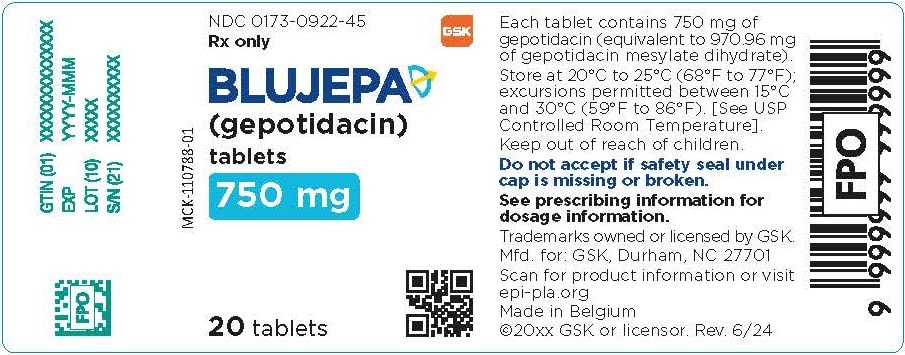
October 14, 2025 (Current Version)
September 16, 2025
September 16, 2025
September 16, 2025
September 16, 2025
September 16, 2025
Blujepa is a new FDA and MHRA-approved antibiotic for uncomplicated urinary tract infections (UTIs) in people aged 12 and older. So, what is blujepa? It uniquely attacks bacterial DNA to combat drug-resistant strains, marking an important advancement in UTI treatment.
Key Takeaways
- Blujepa is the first new oral antibiotic for uncomplicated UTIs in nearly three decades, targeting primarily female patients aged 12 and older and addressing the urgent need for effective treatments against drug-resistant bacteria.
- The innovative mechanism of action of Blujepa involves inhibiting bacterial DNA replication, potentially reducing antibiotic resistance and ensuring effective treatment against a range of uropathogens.
- Clinical trials demonstrate Blujepa’s efficacy, achieving a therapeutic success rate of 51.8%, and while it presents common side effects like gastrointestinal issues, it offers a promising alternative to existing treatments.
Introduction to Blujepa

Blujepa is a groundbreaking FDA & MHRA approved antibiotic for individuals aged 12 years of age and older, marking a significant milestone as the first new oral antibiotic for uncomplicated UTIs in nearly three decades. Developed with partial funding from the US Department of Health and Human Services, Blujepa’s introduction underscores its importance in addressing a critical public health need. But does it live up to the high expectations set by its developers? The us FDA has played a crucial role in the approval process.
The development of blujepa was driven by the urgent need for a new class of treatments capable of tackling drug-resistant bacteria, which have rendered many traditional antibiotics less effective. This support from the government highlights the potential impact developed blujepa could have on public health, particularly for those suffering from recurrent uUTIs.
What sets Blujepa apart is its novel mechanism of action. Unlike other antibiotics, Blujepa inhibits bacterial DNA replication through a distinct binding site, specifically targeting topoisomerase II and IV. This unique approach promises not only to treat infections effectively but also to reduce the likelihood of developing antibiotic resistance. Its safety profile, consistent with previous studies, mainly reports mild gastrointestinal side effects, which we’ll scrutinize later.
MHRA Approval for Blujepa in UK
The Medicines and Healthcare products Regulatory Agency (MHRA) has approved gepotidacin (Blujepa), the first new type of oral antibiotic for uncomplicated urinary tract infections (UTIs) in nearly three decades, for females aged ≥12 years and weighing ≥40 kg.
Uncomplicated UTIs, the most common bacterial infection in women, affecting about half of females in the UK, are increasingly complicated by drug-resistant bacteria; gepotidacin inhibits two bacterial enzymes essential for replication, with activity against resistant pathogens such as E. coli. The recommended dose is two tablets twice daily for five days (approximately every 12 hours). Approval follows two multicentre, randomised, active-controlled Phase 3 trials in females with uncomplicated UTIs (1,572 received gepotidacin and 1,564 received nitrofurantoin), where gepotidacin was at least as effective as nitrofurantoin across patient subgroups, including those with recurrent infections and drug-resistant bacteria.
The most common side effects (≥1/10) were mild diarrhoea and nausea; see the Patient Information Leaflet (PIL) or SmPC for a full list. Emphasising patient safety and access, the MHRA notes the drug’s targeted mechanism may make resistance development more difficult and will continue to monitor its safety and effectiveness. Suspected side effects should be discussed with a healthcare professional and reported to the Yellow Card scheme on the MHRA website or via the MHRA Yellow Card apps.
FDA Approval for Blujepa in USA
GSK’s gepotidacin, marketed as Blujepa, has been approved by the FDA for treating uncomplicated urinary tract infections (uUTIs) in female adults and pediatric patients aged 12 and older.
Gepotidacin demonstrated non-inferiority in the EAGLE-2 trial and statistical superiority in the EAGLE-3 trial compared to nitrofurantoin, a standard treatment.
With its novel mechanism and alternative side effect profile, gepotidacin offers another treatment option that could help decrease resistance and improve care for patients who don’t respond to existing therapies.
Target Audience for Blujepa
Blujepa is specifically targeted at female patients aged 12 and older who suffer from uncomplicated urinary tract infections (uUTIs). Given that over 16 million adult women in the US are affected by uUTIs each year, the potential market for this new antibiotic is vast. Moreover, a significant portion of women will experience at least one recurrent urinary tract infection in their lifetime, emphasizing the need for effective treatment options.
The growing prevalence of drug-resistant bacteria has made the treatment of uUTIs increasingly challenging, leading to higher rates of treatment failure. Blujepa’s approval as the first oral antibiotic for uncomplicated UTIs in nearly three decades offers a much-needed alternative for female adults and paediatric patients, potentially reducing the burden of recurrent infections.
How to Start Using Blujepa
Starting a course of Blujepa is straightforward but requires strict adherence to the prescribed dosage. Patients are instructed to take two tablets, each containing 750mg of Blujepa, twice a day for a duration of five days. This regimen is designed to ensure the antibiotic effectively combats the infection while minimizing the risk of resistance development.
To reduce stomach pain discomfort, it is recommended to take Blujepa tablets after meals to alleviate abdominal pain. This simple precaution can enhance patient compliance and overall treatment effectiveness.
As with any medication, following these guidelines is crucial for achieving the best therapeutic outcomes.
Safety Precautions and Initial Tests
Before starting treatment with Blujepa, patients need to:
- Discuss their complete medical history with their healthcare provider to prevent potential drug interactions and ensure safety.
- Inform their healthcare provider if they are pregnant, as the effects of Blujepa on unborn babies are not fully understood.
- Consult their healthcare provider if they are breastfeeding, to understand the possible transfer of Blujepa into breast milk.
It is also essential that Blujepa is prescribed only for infections confirmed or strongly suspected to be caused by specific bacteria. This ensures that the antibiotic is used appropriately and helps in maintaining its efficacy against target pathogens.
Aesthetic and Practical Design of Blujepa Tablets
Blujepa tablets are designed with patient compliance in mind. Each 750mg tablet is coated to make swallowing easier, which is especially important for those who may have difficulty taking large pills. The coating also plays a crucial role in minimizing gastrointestinal discomfort, a common issue with many oral antibiotics.
The practical design of Blujepa tablets reflects a thoughtful approach to patient needs, combining ease of use with effectiveness. This attention to detail can significantly enhance the overall treatment experience, encouraging adherence to the prescribed regimen. How does blujepa work?
Durability and Storage
To ensure the effectiveness of Blujepa tablets over time, they should be stored at a temperature ranging from 68°F to 77°F (20°C to 25°C). Proper storage is essential in maintaining the antibiotic’s potency and ensuring that patients receive the full therapeutic benefits throughout their treatment course.
Mechanism of Action
Blujepa operates by uniquely binding to different sites on bacterial topoisomerase ii and topoisomerase iv, disrupting bacterial DNA replication. This dual mechanism targets bacterial DNA replication more effectively than many traditional antibiotics, potentially reducing the likelihood of resistance development. Blujepa’s inhibition of both type II topoisomerase enzymes enhances its efficacy against a range of uropathogens.
This innovative approach not only makes Blujepa a potent treatment option but also addresses the growing concern of antibiotic resistance. With its novel targeting of bacterial DNA replication, Blujepa provides a promising solution to a persistent problem.
Real-Life Efficacy
The real-life efficacy of Blujepa is supported by results from pivotal phase III trials, EAGLE-2 and EAGLE-3. These studies demonstrated that participants treated with gepotidacin experienced more favorable outcomes compared to those on nitrofurantoin, a commonly used antibiotic for uUTIs. This comparison of oral gepotidacin versus nitrofurantoin highlights Blujepa’s potential as a superior treatment option.
In the EAGLE-2 trial, therapeutic success was reported in 51.8% of patients treated with blujepa gepotidacin. This success rate underscores Blujepa’s effectiveness in treating uncomplicated UTIs, particularly when existing treatments fall short.
Furthermore, clinical trials have shown that Blujepa is effective against common uropathogens, including antibiotic-resistant strains. This capability makes Blujepa a valuable addition to the arsenal against uUTIs, offering hope for patients who struggle with recurrent or resistant infections.
Common Side Effects
Common side effects reported with Blujepa include nausea, headache, and diarrhea, affecting more than 1% of patients. These gastrointestinal issues are the most frequent adverse effects, consistent with those seen in other antibiotics. Dizziness is another mild side effect that patients might experience.
Being aware of these potential allergic reaction is crucial before starting treatment. Patients should monitor their symptoms and consult their health care professional if they experience any discomfort that affects their daily activities.
Serious Health Risks
Serious side effects such as QTc prolongation, cholinergic effects, and allergic reactions require immediate medical attention. Patients with severe renal impairment or liver impairments are advised against using Blujepa, as these conditions can exacerbate potential risks. Additionally, individuals with heart issues should inform their healthcare providers before starting the medication to avoid complications.
Patients should also notify their healthcare providers of any medications they are taking, as interactions with Blujepa may occur. Regular monitoring by healthcare professionals during treatment can help ensure patient safety and address any adverse effects promptly.
Overall Assessment of Blujepa
Uncomplicated urinary tract infections are among the most frequently occurring infections in women, with many experiencing recurrent episodes. Pivotal trials revealed Blujepa’s non-inferiority to nitrofurantoin, a leading treatment of uncomplicated urinary tract infection. This finding highlights Blujepa’s potential as an effective alternative, particularly for those who do not respond well to existing treatments for uncomplicated uti urinary tract infections uuti.
Blujepa’s unique action can address antibiotic resistance issues that limit the effectiveness of traditional alternatives. While options like nitrofurantoin and sulfamethoxazole-trimethoprim are more affordable, Blujepa’s advanced formulation and potential for fewer side effects may justify its higher cost for some patients.
Value for Money and Alternatives
Blujepa is positioned as a premium option in the antibiotic market, effectively targeting uncomplicated urinary tract infections. While alternatives like nitrofurantoin, fosfomycin, and sulfamethoxazole-trimethoprim may offer more cost-effective solutions, Blujepa’s unique mechanism and effectiveness in treating UTIs could justify its higher price for some patients.
Summary
In summary, Blujepa represents a significant advancement in the treatment of uncomplicated urinary tract infections. Its novel mechanism of action, supported by robust clinical trial data, offers an effective alternative for patients, particularly those facing antibiotic resistance. Despite common side effects like nausea and headache, Blujepa’s potential benefits make it a promising option for many.
As we look to the future, the introduction of Blujepa highlights the importance of continued innovation in antibiotic development. This new treatment offers hope for improved patient outcomes and underscores the ongoing need to address the challenges posed by drug-resistant bacteria.
Frequently Asked Questions
Is Blujepa available in the USA?
Yes, Blujepa, which contains the active ingredient gepotidacin, is available in the USA following FDA approval for treating uncomplicated urinary tract infections.
Is Blujepa available in the UK?
Yes, Blujepa, which contains the active ingredient gepotidacin, is available in the UK following MHRA approval for treating uncomplicated urinary tract infections.
How does Blujepa work?
Blujepa effectively combats bacterial infections by targeting and inhibiting two crucial enzymes, DNA gyrase and topoisomerase IV, necessary for bacterial DNA replication. This mechanism leads to bacterial death, making it a bactericidal antibiotic.
Who can use Blujepa?
Blujepa can be used by individuals aged 12 years and older, specifically women and girls experiencing uncomplicated urinary tract infections.
What are the common side effects of Blujepa?
Common side effects of Blujepa include nausea, headache, and diarrhea, experienced by more than 1% of patients. It is important to consult a healthcare professional if these effects persist or worsen.
Are there any serious health risks associated with Blujepa?
Yes, Blujepa poses serious health risks such as QTc prolongation and potential allergic reactions, necessitating immediate medical attention. Individuals with severe kidney or liver impairments should refrain from using this medication.
Medical Disclaimer
NowPatient has taken all reasonable steps to ensure that all material is factually accurate, complete, and current. However, the knowledge and experience of a qualified healthcare professional should always be sought after instead of using the information on this page. Before taking any drug, you should always speak to your doctor or another qualified healthcare provider.
The information provided here about medications is subject to change and is not meant to include all uses, precautions, warnings, directions, drug interactions, allergic reactions, or negative effects. The absence of warnings or other information for a particular medication does not imply that the medication or medication combination is appropriate for all patients or for all possible purposes.





